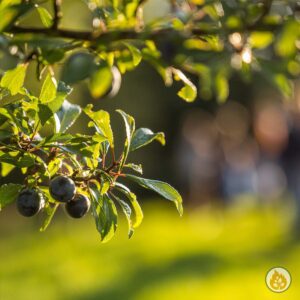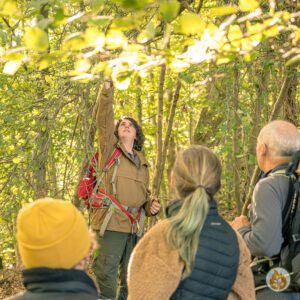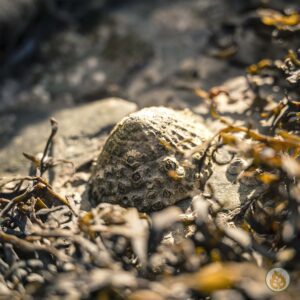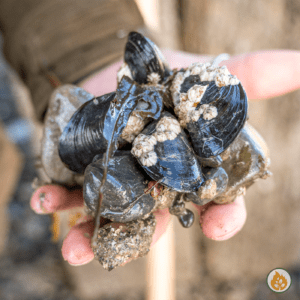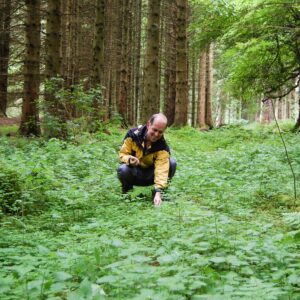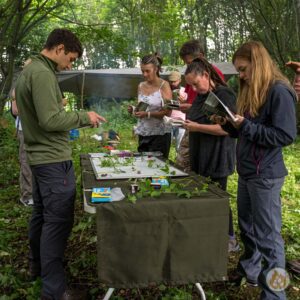
Pignut
Conopodium majus
Alternative names: Hognut, Earthnut, Cat Nut, Kipper Nut, Jarnut, Narnock, Jog-Journals
Pignut (Conopodium majus) is a woodland plant with an edible root. It’s a popular plant with many foragers – probably as much for the effort it requires to locate, identify and excavate the edible tuber as for the taste and calorific content.
Where do Pignuts grow?
Pignuts are found on the lighter edges of woodlands and are often a marker of long-established grasslands. They never (or extremely rarely) grow in alkaline soils and prefer broken or previously disturbed soil, often just on the edge of tracks and footpaths. They’re found throughout Europe and parts of North Africa – completely unrelated plants also share the name Pignut (such as Pignut Hickory Carya glabra from North America) so be sure to check the latin name in guides and books for your local area. As excavating the edible part of the plant will require digging it up you will need permission of the landowner – and also be aware of the dangers and legal hazards of accidentally digging up a protected species such as Bluebell Hyacinthoides non-scripta.
Are Pignuts edible?
The tuber of Pignut is edible and will need some careful work to safely extract from the soil (see below). Once cleaned and with the outer skin removed they can be eaten raw but are best (in my opinion) lightly roasted in a pan or used like a giant chickpea in drier curries and other dishes. There is a little debate over how much use they are as a foodstuff, particularly as a source of carbohydrate. Badgers certainly enjoy them and seek them out, often foraging for them alongside Bluebells and other edible roots. Pignuts were certainly used as a food source in times of hardship for some country folk and can be used as a survival food.
How to identify Pignut
The edible part of the plant Pignut is the root/tuber that is found about 10-25cm under the surface of the soil. The leaf (and later the umbel-type flower) are the markers that identify the plant for the passing forager, but some effort will be needed to carefully excavate the ‘nut’ itself. The root (also called a nut or corn) looks a bit like an ugly chestnut, often with three lumps on one side – sometimes referred to as being a pig’s face! Care should be taken when digging up the root to ensure that you do not snap the stem of the plant before you find the ‘nut’. The stem is fragile, and the easiest method is to break up the soil with a small pointed stick (or very gentle use of a spade/trowel) then use fingers to remove the loose soil around the stem until the root appears. To be on the safe side it is best to keep the leaf/stem attached to the root to ensure you have dug up the correct root (and not , for example, the toxic/potentially toxic Bluebell or Lesser Celandine root/bulb) Pignuts are one of those great examples of pattern-recognition and the way our brains pick up ‘useful’ shapes once they have been trained to. The soft, green leaves of Pignut (similar to other members of the Carrot family to which Pignut belongs, Apiaceae) are sometimes tricky to separate out from the background noise of the rest of the forest floor, but a little effort and some practice will help.
Potential dangers and misidentification
Misidentification of Pignut can occur both above and below ground. Above ground the other members of the carrot family can cause issues, with the leaves and flowers potentially being mistaken for Hemlock (Conium maculatum) or Fool’s Parsely (Aethusa cynapium). The leaves of Pignut are particularly distinctive and with a bit of practice the differences in the shape and pattern of both the leaf and the flower will become more obvious. Below ground the most likely problem a Pignut forager will come across is the stem snapping off and being unable to positively identify the tuber. There are several plants that grow in the same areas as Pignut that have potentially toxic roots/bulbs (Bluebells are toxic, Lesser Celandine Ficaria verna roots need to be thoroughly cooked before eating) and if you just start digging in a patch of these plants it can be difficult to isolate Pignut roots for the novice forager.
** A NOTE OF CAUTION **
Foraging and hunting for wild food is a potentially hazardous activity.
Whilst we do our best to make sure these species and wild food guides are as accurate as possible there is ALWAYS the possibility of the user (or the author…) misidentifying a plant or other item, and the descriptions given might also apply to similar toxic plants.
Common names cannot be relied upon as they change from region to region, and there are some similar names for very different plants. When researching species on the internet you can sometimes find a common name referring to a completely different species to the one you are trying to learn about.
You should always be confident of the identification of a plant, fungus or lichen BEFORE you touch it and especially before you put it anywhere near your mouth.
The best way to do that is by checking with a good wild flower key or identification book, and ideally cross-referencing between more than one book.
Or – as all of the cool people say: Never Munch on a Hunch.

Richard is a UK wilderness skills and outdoor safety instructor with over a decade of experience working on expeditions, in SAR, training the military and emergency services.
A passionate forager, hunter, angler and outdoorsman, he has appeared on television and web series numerous times, and is a regular contributor to podcasts, magazines and other publications.




